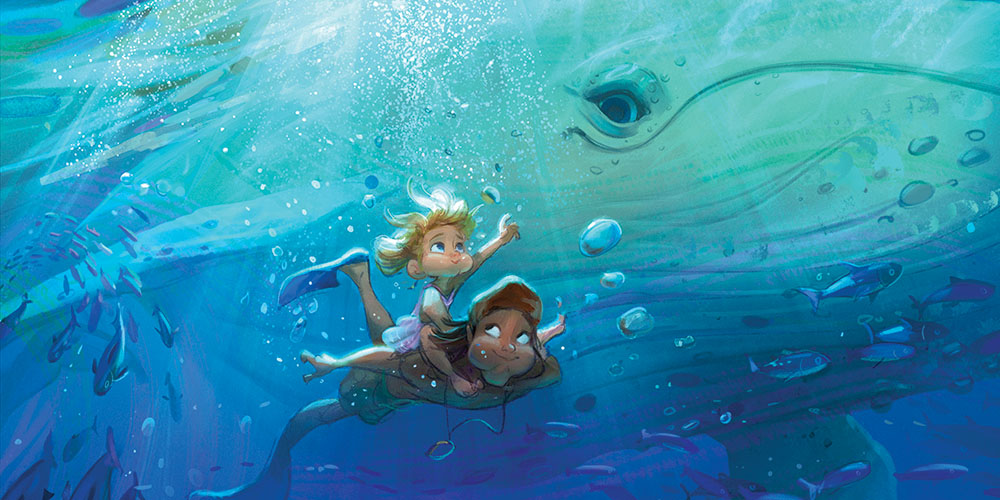Wearing a blue sun-patterned bandana and gray T-shirt, Garrett Gee sat in front of a camera to tell his fans why they shouldn’t invest in his company. The unusual pitch was about a new venture based on The Bucket List Family, a travel and lifestyle Instagram account and YouTube channel that documents the nomadic life that Gee, a creator and entrepreneur who sold his company Scan to Snapchat in 2014 for $54 million; his wife and Bucket List CEO, Jessica; and their young children, Dorothy, Manilla and Calihan, have lived since 2015.
In the video, titled “3 Reasons WHY You Should NOT Invest in the Bucket List Studios,” Gee recounted how, in 2020, he brought his idea for an animated series based on his family and their travels to some of the top studios and streamers, including Netflix and Disney. The meetings went well, Gee says, and he wound up receiving a $10 million offer for the show. But after discussing the deal — which would entail losing ownership over intellectual property — with Jessica, Gee said the two decided to take a risk and walk away from the offer. Instead, they would embark on something more daring: launching a full entertainment studio to create content, products and experiences that embody the ethos of the Bucket List Family, which encourages others to travel and explore the world together.
To achieve this, Gee says the family wanted to raise $7 million — and they wanted their fans to become investors rather than relying solely on traditional VC buyers. But before making the appeal to viewers to open their wallets, Gee cautioned in the spirit of full transparency that Bucket List Studios would operate like a startup, that Garrett and Jessica would prioritize the well-being of their family over the success of the business and that growth of the company would be slow — and, with that, there was the risk of failure and investors losing their money. Gee also noted that making money was not their primary motivation. Instead, Gee leaned on the “do good” impact of the venture and the possibility of sharing the rewards — in the form of company equity — with their most engaged fans.
“When you experience something special, truly special, the first thing you want to do is share that with others,” Gee says in the video. “We as a family have had this special opportunity to travel the world together, explore, create memories — that’s the true treasure in our lives. And if all of this work, all this effort, teaming up together with you, if we can take that and share that with other families and different cultures in different countries, it’ll all be worth it.”
After the video went live at 7 a.m. March 21, 2021, fans and other prospective investors could submit a Google Form that indicated how much money they were interested in investing, in exchange for equity in the company, with the lowest option set at $100. Sitting by their computer, Garrett and Jessica opened a companion spreadsheet to monitor submissions in real time. The Gees hoped they would hit around $3 million in commitments. They hit that mark just 12 minutes after the video was live.
An hour later? $10 million. Twenty-four hours later? $40.2 million.
“It was absolutely crazy,” Gee tells THR. Ultimately, Gee says he decided to cap the crowdsourced investments to a total of $10 million so that he and his family could retain a majority stake in the company, which they valued at $30 million, according to an investor pitch deck seen by THR. So they asked some of those who expressed interest to scale back their investment and turned away others entirely.

In total, Bucket List Studios received $7 million from 34 investors who have put in funding in the $100,000 to $3 million range — and $3 million from around 30,000 investors at the $100 level, according to Gee. The company’s authorized share capital includes 20 million shares of common stock and 10 million shares of preferred stock, with roughly 2.5 million being designated as series seed preferred stock, according to financial documents reviewed by THR. Gee holds about 5.1 million shares of common stock, representing about a 50.4 percent stake in the company.
Though the company received overwhelming support from those $100-level investors, Bucket List Studios still has the backing of VC and private investors, including Jonathan Triest of Ludlow Ventures, Chris Redlitz of Transmedia Capital and Sam Hinkie, the former GM of the NBA’s Philadelphia 76ers.
Redlitz, who invested in Gee’s tech company, says he was compelled to continue supporting the Bucket List Family both because of its bona fides as a business and because of its ethos. The 30,000 other investors at the $100 level still have equity in the company but do not individually have voting rights; instead, an external head custodian, Prime Trust, represents the group and holds the voting power.
“It’s really smart that you’re engaging people at a higher degree than just subscribers or followers,” Redlitz says. “If they actually put some money up front, even if it’s $100, they feel like they’re part of this mission.”

Bucket List Studios also could serve as a case study for other creators seeking to raise money at the same level and retain control over their work. Because for Gee, the prospect of losing so much ownership to a studio was the deal-breaker that “scared” him away from the $10 million offer.
“When I would have conversations with their creative teams or their business teams, they were very open to my involvement and my thoughts and everything. But when the contracts came … it was much more aggressive,” he says. “They had final say. They had full creative control. They had full ownership over all our creative endeavors moving forward. They owned our YouTube channel, past and moving forward. They own our name rights, even my kids’ name rights.”
Ellie Heisler, a partner at Nixon Peabody who specializes in entertainment and IP law, says she could see more creators following a similar crowdfunding route for larger projects to maintain ownership and control over their work.
“The minute you start to go the traditional route and sell a show to a studio or network, you lose ownership, you lose control, you lose the opportunity to integrate the brands that you may have a relationship with and work with because now they’re competing interests,” Heisler says. “For a content creator that’s used to having sole control over [their] creative, sole control over any brand integrations, sole control over the editing and the final product, it’s such a departure.”
Now with millions of fans behind them, the Gees are moving forward with the animated series that sparked the creation of Bucket List Studios. And Garrett is back to taking meetings with the major studios and streamers. But, this time around, he and his family are the ones in control.
This story first appeared in the Oct. 19 issue of The Hollywood Reporter magazine. Click here to subscribe.

